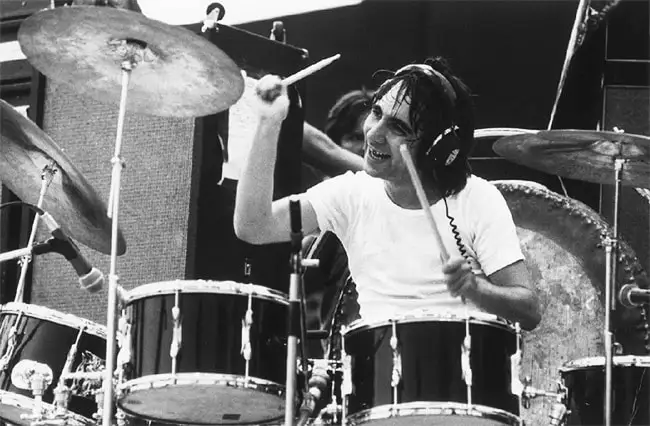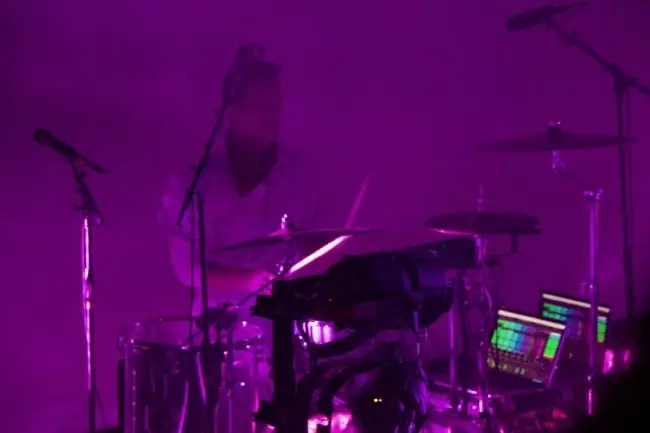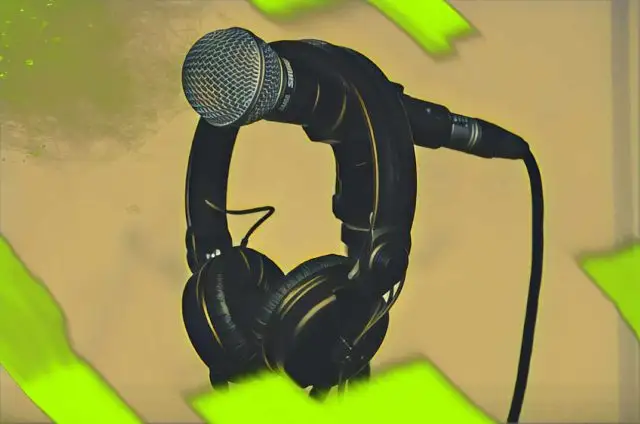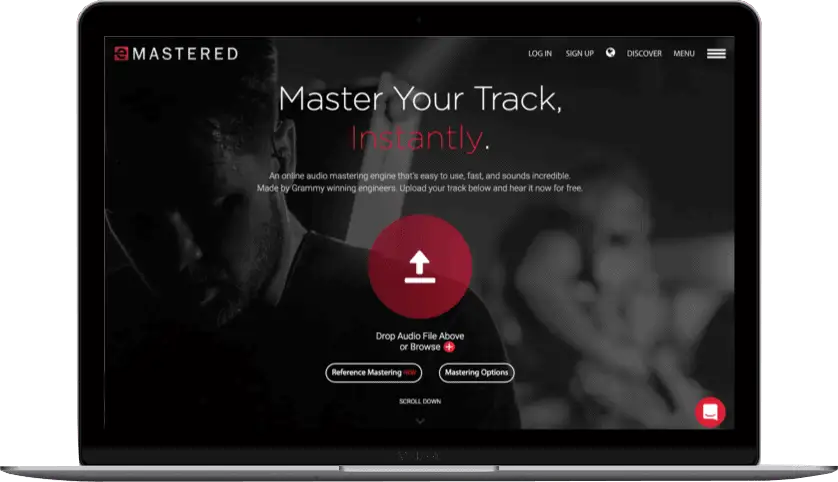If you've been to a medium/large size music concert in the last 20 years, you've most likely heard backing tracks, even without knowing it. This is a technique that's been used in live music since the 1960s, yet only recently has it become so widespread as to impact smaller acts.
A combination of technological advancements and audience demands is making the use of backing tracks in live music more and more common. And while for many this is the death knell of live music as we know it, backing tracks are undoubtedly useful for both practicing and enhancing a live performance.
In this article, we'll discuss all about backing tracks: their history, technology, purposes, and how you can use them to improve your artistry.
What is a Backing Track?
A backing track is a pre-recorded piece of music or sound that musicians can use to play along during a practice session or rehearsal.
Anything can be used as a backing track. It could be an additional guitar, backing vocals, an ambient layer, or a drum part. During a live performance, performers and pre-recorded music should be perfectly aligned to create a seamless blend of the live/recorded elements.
Backing tracks are used to create a richer sound whenever it is needed. Rock bands can add orchestral elements to their shows, and busker artists can tour with minimal equipment without sacrificing quality.
For home practice, backing tracks are used to learn new songs, master solos, or practice being on-tempo. They’re an effective and fun way to hone one’s music skills.
A History of Backing Tracks
Although it might feel like a recent technological advancement, backing tracks have been used by rock and pop artists for decades.
Starting from the 1950s, TV shows often required bands to play on track while the vocals were live, either to avoid technical issues or because they didn’t have the equipment or staff necessary to run a full-band live performance.
The experimentations in the recording studios of the late '60s and '70s changed the way people used backing tracks. At the time, artists and producers started exploring the potential of tape machines, bringing to life complex sonic layers that were almost impossible to recreate live by the band.
Back then as it is now, bands had a few options. They could either ignore the option of enhancing their records and keep them as “live-like” as possible. They could use the technology to enrich their records and reinterpret live shows so that they could be performed by the players on stage only. Or, finally, they could fully embrace the technology, using it both in the recording studio and while performing.
Of the latter, an early example that comes to my mind is The Who, with Keith Moon wearing headphones on stage to play to a backing track. That’d make sense if you think of the music the band was releasing in the early 70s: the rich overdubbed sound of some tracks and albums they made at the time (think of Baba O’Riley or the entirety of Quadrophenia ) was impossible to recreate live as a four-piece rock band.

But the list of bands employing the new technology in one way or another was already quite long at the time, and as tape machines became smaller and widely available, more and more bands started using backing tracks live.
The 80s and 90s were really the eras when backing tracks became standard equipment on stage. Live events started being treated as audio-visual experiences, with videos, dancers, or additional sounds to make the experience more immersive. As a result, artists and producers started adding sequencers, drum machines, and other pre-recorded tracks that could be synced with live instruments.
Once again, it makes a lot of sense if you think about the type of live performances that became popular at the time. Pop singers often had to perform physically demanding dance choreographies, which made it hard to play and sing at the same time. As a result, many used vocal backing tracks while the musicians played live.
As it’s been the case with anything else in music production, DAWs (Digital Audio Workstations) popularized backing tracks, making them accessible to artists of all levels. The result of this is that most artists, be they seasoned musicians or new acts, use backing tracks to enhance their live shows.
I’ve played the drums for decades, so whenever I go see a concert, I always keep an eye on the rhythm section. Nowadays, most drummers who play pop or pop-rock use backing tracks; you can see it because they wear headphones or have a laptop near them to activate pre-recorded tracks. It’s just standard procedure these days.

Playing with backing tracks is no trivial task. You need to be able to play to a click track perfectly while keeping your live performance fluid and focusing on what your bandmates are doing. In my experience, it takes time and quite a few concerts to get it 100% right.
That said, using backing tracks can make your shows more engaging, richer, and sound closer to the recorded album.
While some consider it as "cheating," there are many ways to use backing tracks, whether on stage or when practicing at home. Finding a way to use them that enhances your skills and preserves your creative integrity should be a top priority if you decide to embrace this technology.
Backing Tracks for Practice
Let’s face it: practicing along to a metronome sucks.
Speaking from a drummer’s perspective, the metronome helps you craft the most crucial skill you need as a band member: the ability to keep a consistent tempo. But that doesn’t make it any less boring as practice.
But what if you could practice playing on top of the songs you love, exploring the time signatures and tempos that defined them?
That sounds like much more fun, and that’s precisely what backing tracks allow you to do when practicing at home.
You can find backing tracks of the songs you want to learn online; there are plenty of websites that offer the possibility to download carefully crafted backing tracks with isolated instruments so that you can sing or play along with your musical instruments without the track you're replacing with your live performance.
As I mentioned earlier, practicing with backing tracks is also a great way to expand your sonic palette. If you want to move away from the overused 4/4, how about finding a song with an odd time signature? Not only can this help you craft inventive guitar solos but also make you more used to time signatures outside of your comfort zone.
Most importantly, it makes practicing more engaging and enjoyable. Towards the end of the article, I’ll talk about a few great websites I’ve used for backing tracks over the years, so I suggest you give them a try for your home practice. You won’t regret it.
How To Create a Backing Track for Practice
Practice is a personal process that you need to tailor to your needs. That said, I can tell you how I use backing tracks for practice, and then you can see for yourself whether these tips make sense to you.
There are a couple of reasons why I create my own backing tracks: to practice a solo or to create pre-recorded content I'll use live, either with my band or as a solo artist.
When I’m practicing a solo (I sometimes play the synthesizer in my band), I usually recreate the entire song on my DAW. This means that I:
- Create the drum part with a virtual drum kit
- Add the bass line
- Add the guitar riff (optional)
All this can be done with a DAW and a series of virtual instruments depending on your needs. In my case, I don’t need the bass guitar to sound exactly like my bandmate’s gear: I just need to get the melody right, so that I can play on top of it, and that whatever I practice at home can be reproduced live.
The most important things are the song’s tempo and the melodies. Once you get those right, you can practice your solo.
If you’re practicing a cover song, most likely you won’t need to do any of this. You can find plenty of professionally-recorded backing tracks online, free or paid, so all you have to do is download the song, import it on your DAW (if you want to record yourself), and play along.
When choosing the pre recorded track for your cover song practice, make sure you get one that doesn't have the instrument you're practicing. For instance, if you're trying to learn a guitar solo, it'd be good not to hear the real solo in the background so that it won’t disturb you. That’d also make it easier to come up with your own variation of the solo!
Music Backing Tracks for Live Performances
Let’s start with a simple question: how can you play a backing track live?
First of all, the song needs to be locked to a click, meaning the drummer needs to have earphones playing the metronome at the song’s tempo.
This is crucial because you can’t control the speed of a backing track the same way as you can change the speed of a song played live on stage. If you accelerate a song, even by a fraction of a BPM (beats per minute), you’ll end up with a desynced backing track.
When you start the song, you’ll need to trigger the sequencer with the backing track. This can be done by the drummer (who is responsible for the song’s tempo) or by the sound engineer.
Starting the song at the right time is usually the hardest part. If you have backing tracks made by a recording studio, they’d usually come complete with the name of the song and a count to four. This means that if your song is called Itsy Bitsy Spider, and you had a backing track made by a recording studio for it, it’d start as follows:
Itsy Bitsy Spider….1….2….3….4
If you’re wondering whether this is necessary, allow me to remind you how Ashlee Simpson’s career ended . In short, you want the information about your backing tracks to be as clear and foolproof as possible.
Now, as for the way you can use backing tracks, whether you're a busker artist, a professional cruise singer, or a member of a heavy metal band, your requirements will change dramatically.
The options are endless, with bands adding extra guitars during a solo, backing vocals during the chorus (when live vocal run parallel to a backing track), or extra sound layers to make your songs more immersive in certain parts. If you're a one-man band, you'll need to compensate for the lack of other instruments with tailor-made backing tracks.
Regardless of the reason why you use backing tracks, remember that the technology is supposed to enhance your live show, and not to replace you or any other member of your band .
The common trend these days is to automate as many things as possible in order to make concerts run smoothly. Backing tracks and MIDI technology allow you to control guitar pedals, sound effects, lights and visuals through a laptop, which simplifies the lives of musicians and tech guys, but also takes away a lot of the live experience the audience expects.
After all, you’re supposed to be playing live at your concert, isn’t it?
With this in mind, let’s see how you can create backing tracks for your gigs.
How To Create a Backing Track for Live Shows
The equipment
The basic audio signal of backing tracks looks like this: Source + Audio Interface + Console
The source is where your backing tracks are stored, which could be anything from a laptop to an MP3 player.
The audio interface is a device that connects musical instruments to computers and/or computers to mixers. While you might be able to connect the source directly to the mixer, having an audio interface gives you more flexibility and multiple input/output options, so I strongly recommend you get one.
Finally, the console is where all the sounds are balanced together, so that every instrument will sound loud and clear in the venue you're performing in. Since you'll be using backing tracks, these will need to be mixed together with the music that'll be performed live to give a realistic feel to the show.
You’ll also need an in-ear monitoring wireless system to hear the sound mixed by the front-of-house mixer.
If you have all this tech, then you’re ready to use backing tracks live! Now we need to define what kind of audio we want to feed into the mixer.
Mono Mix vs. Stereo Mix vs. Stem Mix
Before we start this section, let me underline that the audio quality of your audio file needs to be spot on. A professional mixer won't turn your MP3 files into immersive soundscapes, so make sure you render your songs in lossless formats and that the music is cohesive and balanced.
With that in mind, let’s see the different formats you can use for your backing tracks.
Mono Mix
A mono mix combines all the musical instruments into one channel, sending to the mixer a balanced sound but without any spatial separation. This is ideal for small venues where the stereo effect isn't important or if sound consistency is crucial for your show.
Mono mixes sound the same regardless of the listening point and were the most popular option until a few years ago. Nowadays I think they’re the best option if you want to keep things simple, but for a more immersive experience, I’d recommend the next two options.
Stereo Mix
A stereo mix splits the sound into two channels (left and right), which enhances the sense of space and depth of your backing tracks. This creates a more realistic and enveloping live experience, and it's also great to have some ping-pong stereo effects that can make a live set more exciting.
Also, since most likely your album was recorded in stereo, the audience will hear music that sounds very much like your album.
Stem Mix
Sending stems to the front of house is the most professional way to use backing tracks, but it comes with some caveats. The sound engineer needs to be familiar with your set, so I'd recommend you use stems only if you have tech guys who are traveling with you or you know you can trust.
That said, stems give full control to the mixing engineers, who can tailor sounds to each venue, bringing to life the best sounds in every circumstance.
The Ongoing Debate: Pros and Cons of Using Backing Tracks Live
The debate on whether bands should use backing tracks live or not has been going on since the 70s, but the wider availability of the technology has further intensified the conversation over the last decade.
When it comes to the audience's expectations, there are different philosophical approaches to live music. A fan might go to a concert and expect the band to play exclusively live, without additional embellishments. Someone else might go to the same concert and expect to listen to songs that sound close to the album sound.
My impression is that the latter is becoming more common, especially in more “commercial” music: pop, rock, and similar.
This is the result of modern audiences expecting a polished and refined sound when seeing a concert, but also of artists adding extra layers of sound while recording an album and not being able to recreate them live without backing tracks.
Whatever the reason, the use of backing tracks in live music is extremely common these days, and it’s unlikely that artists will stop using them anytime soon.
As in most cases, the difference between positive and negative usage of backing tracks depends on how much you rely on them.
Last year, post-hardcore band Falling In Reverse canceled a concert because their laptops went missing while on tour, showing that the band relied heavily on backing tracks and MIDI programming for their shows.
A few years ago, Japanese rock band BAND-MAID lost part of their musical instruments and laptops with all their backing tracks before a concert in Helsinki. That night, they managed to perform just fine.
Do you see where I'm going with this? If you lose your backing tracks, and the only option you've got left is to cancel the show, then you're probably relying too much on them. After all, this is your show, and these are your songs, so not being able to arrange a live performance of your own pieces without relying on backing tracks is a bad sign.
There’s also an ongoing discussion about whether using backing tracks comes at the cost of artistic spontaneity. Once again, the technology itself is not the issue, but rather how it’s used that makes the difference.
An extra guitar riff during a solo can enhance the beauty of a piece. An orchestral section can make a song more poignant and closer to the recorded version. These are subtle changes to a performance that can make it more engaging and enjoyable.
If all of your shows are identical because you're playing on a click, use backing tracks heavily, throw MIDI sounds everywhere, use your laptop for elaborate lighting effects and MIDI programming, and most of all, realize you can't play your own songs without all this "augmentation," then you're probably walking on a very thin line between artistry and fraud.
That said, when used right, backing tracks allow you to enhance your concerts in ways you wouldn't be able to achieve without them and simplify your life while on stage.
From using backing tracks to enhance your songs, programming your pedalboard, coordinating bandmates through clear cues, and protecting your ears by having a clear sound coming out of your IEMs, using backing tracks can be beneficial in countless ways, so long as it doesn’t take away the spontaneity of your performance.
Five Tips If You Use Backing Tracks Live
I want to dedicate the final part of this article to some practical tips that can help you get started when using backing tracks, especially on stage. Some of these are pretty obvious but often neglected even by seasoned musicians, but are a must if you aim at creating a professional experience for your audience.
1. Get a Backup Device (or two)
Things break, especially when bands tour. I was in Kobe (Japan) last year when my laptop’s graphics card broke a day before a gig. Trust me when I say that having a backup device, be it a tablet, smartphone, or an extra laptop, will make your life easier (and less stressful.)
Test your equipment before every concert. Even if last night's concert went smoothly, it doesn't mean your equipment is still functioning perfectly today. Finally, put your backup devices in different bags to reduce the chances of losing them all.
2. Convince your drummer the metronome is not evil
To keep everyone in sync with the backing track, your drummer must hear a click track. I suggest having the click track panned hard on one side and the backing tracks hard on the other: in this way, the drummer will hear both perfectly but also be able to separate the metronome from the backing tracks.
3. Use In-Ear Monitor Systems and Learn How to Use Them
In-ear monitor systems can be customized to your needs, so take some time to learn how to balance the mix, manage volume levels, and craft a sound that won’t cause ear fatigue. Choose earphones that'll fit your ear canal perfectly, as you don't want them to fall in the middle of a performance.
4. Use MIDI to Send Info to Pedalboards and Turn on Effects
The power of MIDI programming is extraordinary when it comes to live music. For instance, a guitarist can automate their pedalboard, so they won’t have to activate or adjust effects while performing, allowing them to fully focus on their guitar playing.
The same goes for sound effects, lead vocal effects, light effects and visuals. This means that MIDI programming has the potential to turn your gig into a multidisciplinary, immersive live experience.
5. Create Emergency Backing Tracks in Case a Bandmate Can’t Make It
Chances are you'll have to cancel the show if the singer loses their voice. But if your drummer, bass player, or guitarist can't make it, you might want to consider having customized backing tracks that'd allow you to perform for one night even without them.
It’s not ideal, we all know that. But remember that your fans are your most valuable asset, so I’d recommend you do whatever it takes to not have to cancel a gig.
Where to Find Vocal and Instrumental Backing Tracks
There are plenty of resources for musicians looking to find high-quality backing tracks for practice, karaoke, auditions practice, or to enhance bands' sound. Here are a few I’ve used over the years:
Piano Trax
Website: https://www.pianotrax.com/
Price: $4 to $6 per song
I recommend Piano Trax to anyone looking for high-quality piano accompaniments, with a vast selection of musical theater, pop, and timeless songs. The website has been running since 2006, and the catalog provided is as extensive as it is diverse.
onlineMD
Website: https://online-md.co.uk/
Price: Starting from £1.00 per song
Run by husband-and-wife Alan and Lindsay, onlineMD provides affordable and customizable backing tracks across genres, whether for practice, rehearsals, or professional performances. What I like about onlineMD is the possibility to tailor your backing track to your needs, from more stripped down recordings to a fully orchestrated backing track.
Karaoke Version
Website: https://www.karaoke-version.com/
Price: around €1.99 per song (discounted prices for subscribers)
Here you’ll find an immense catalog of instrumental and karaoke tracks ranging from pop to heavy metal music. Karaoke Version is great for anyone who wants to practice their musical instrument at home, as it offers the option to download tracks with certain instruments muted.
Jamzone
Website: https://www.jamzone.com/
Price: freemium (from free to $17.99/month)
Here’s an interactive app that offers way more than backing tracks, with real-time chord charts and a multitrack console to adjust the sound to your needs. Jamzone is perfect for jamming and practice, but it also does a great job live, thanks to the option to create a custom mix of instruments on the go.
Sing Broadway Now
Website: https://www.singbroadwaynow.com/
Price: from $7 to $99
Specialized in Broadway-related musical tracks, Sing Broadway Now is the best option for those interested in musicals who want carefully crafted backing tracks to practice with.
6 iReal Pro
Website: https://www.irealpro.com/
Price: $20
A fantastic app that many consider a must-have, iReal Pro not only offers customizable backing tracks for jazz, pop, and rock music, but also extensive chord charts and real-time transposition. Ideal for musicians interested in practicing improvisation or jamming jazz standards.
I've also been told that Music Backing Tracks (MBT) is one of UK's most popular backing tracks provider. It's been around since 1985 and offers a vast array of tracks, so do check it out if none of the options above suit your needs.
Final Thoughts
I hope this guide will help you make the most of backing tracks in every circumstance. My final recommendation is to use it sparingly until you can master it, especially on stage: there's nothing worse than making your performance sound flat and unnatural because of not tailor-made backing tracks.
Finally, don't let technology take away the beauty of live playing; rather, use it to enhance the connection between you and your audience. There's something genuine and powerful when albums capture essentially how a very good band sounds live, so use the technology to improve your sound, but don't allow backing tracks to replace your artistry.
Have fun!





